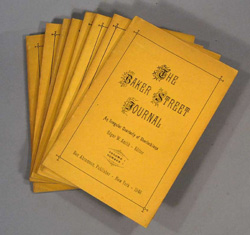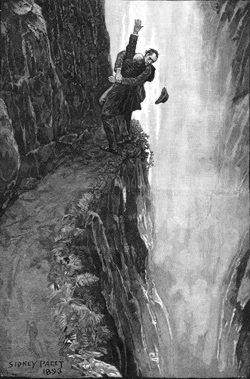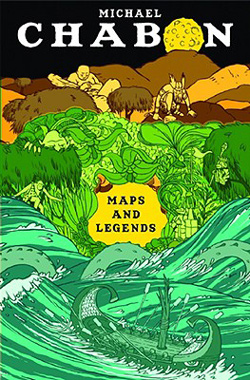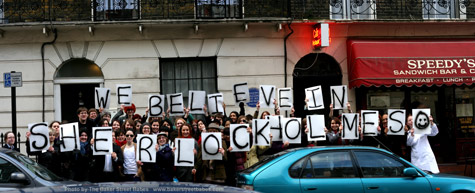 I recently met a lovely woman. She was young, and attractive, and smiling, and redheaded—in short, she seemed perfectly normal. After about five minutes, however, I’d identified that the object cradled in her lap was an issue of the Baker Street Journal—the unbelievably specific, scholarly publication devoted exclusively to essays about the Great Detective, the periodical that embodies Christopher Morley’s remark, “Never has so much been written by so many for so few.”
I recently met a lovely woman. She was young, and attractive, and smiling, and redheaded—in short, she seemed perfectly normal. After about five minutes, however, I’d identified that the object cradled in her lap was an issue of the Baker Street Journal—the unbelievably specific, scholarly publication devoted exclusively to essays about the Great Detective, the periodical that embodies Christopher Morley’s remark, “Never has so much been written by so many for so few.”
She had fooled me, this effortlessly groomed and seemingly sane woman. Like calls to like, however, and I saw through her charade. Like her, I enjoy summer dresses and kitten heels. Like her, I can pass for normal. But I’d contributed to the Baker Street Journal she was holding, for the love of tumblr and all its otters. We are both Sherlockians, hardcore full-frontal triple-X Sherlockians with journal subscriptions, masquerading as… well.
As not-nerds.
We are not quite normal, we Sherlock Holmes fanatics, supposing normalcy exists. Of late, however, there are a lot of us. There are a very, very great many, in all shapes and sizes and colors and ages, and we daily gain recruits to our geekish hordes. Brainy, you could argue, is the new sexy. Which leads me to ask two questions.
Why now? And why Holmes?
Sherlock Holmes as a pop culture god is nothing new, we must remember—he was adored upon initial publication, and he enabled Sir Arthur Conan Doyle to afford a summer house in Shangri-La and a solid gold commode (presuming Doyle wanted either of these things, which we can infer he did not). When Doyle summarily axed Holmes by allowing a reedy mathematician named Professor Moriarty to poke him in the sternum until he fell off a waterfall in “The Final Problem,” the Strand Magazine lost 20,000 subscriptions. When Doyle looked in his coffers and discovered he could no longer afford to encrust his privy in rubies, so to speak, and he began to publish The Hound of the Baskervilles in installments, the Strand gained 30,000 new subscribers almost overnight.

We nerds can kick our heels up over it, though, and throw our heads back with teeth gleaming as we cackle, and wallow in our own new productions until our fingers are pruney.
Inarguably, the main thrust of the present craze is the infamous trio of widely disparate adaptations: CBS’s exceptional procedural Elementary, the grittily glorious Sherlock Holmes films from Warner Brothers, and the masterful BBC series titled simply Sherlock. The American series, which features Jonny Lee Miller as Sherlock and Lucy Liu as his Joan, combines the formula of the police drama with snappy writing and truly diverse casting choices. The soon-to-be film trilogy, starring Robert Downey. Jr. as Holmes and Jude Law as Watson, present explosive detonations of beef-laced steampunkian meat ragù, replete with swords and guns and doomsday devices, bursting like a nitroglycerin-fueled Sherlockian piñata across the big screen. And the British series, starring Benedict Cumberbatch as Sherlock and Martin Freeman as John, are symphonic modern-day riffs on the original stories, managing to be searingly intelligent and gut-wrenching small screen gems simultaneously. None of these shows are perfect. All three are fantastic. And we geeks rejoice at our embarrassment of riches.

It would be tempting to say that in times of trouble, when the economy is a steaming pile and politics manages to be at once inane and vicious, we turn to nostalgia for comfort, and that is why Holmes is enjoying a new heyday.
Tempting, and dead wrong.
The Warner Brothers films have updated Sherlock Holmes into a scruffy, gasoline-swilling, indifferently heterosexual boxing champion and James Bond figure (he boxed in the canon as well, so we don’t quibble). CBS and the BBC have abandoned the Victorian Era entirely (they include enough fannish easter eggs to feed an army, so we don’t quibble about that either). To the few purists who are fussed over this sort of thing, I would recall to mind Doyle telling stage actor and adapter William Gillette (who built an actual castle on his related earnings), “You may marry, murder, or do what you like with him,” since the author’s opinion of the character who enabled his bidet to be made of carved rhino horn was famously a low one.
What was Doyle writing, then, in essence? Why does Sherlock Holmes work so well when lifted out of his original ecosystem? First of all, the series of four novels and fifty-six short stories were conceived to appeal to a contemporary audience—thus, is it no less appropriate for the BBC to dress Sherlock in a Belstaff coat than it was for Basil Rathbone to don a fedora when fighting Nazis. The original tales are thrillingly atmospheric little jewel boxes of efficient prose. But that is not all they are. And therein, I think, lies the crux of the matter.

I have always maintained that people read the Sherlock Holmes mysteries for the first time to learn the solutions to the crimes; they read them over and over again subsequently in order to spend time in the company of the greatest literary friendship of all time. And some of us afterward discover more in the way of friendship than merely Holmes and Watson.
Be your fannish oeuvre the Baker Street Journal or LiveJournal, your meetings web-based or yearly conducted in New York City in the dead of winter, your interests reproducing Irene Adler’s wardrobe or designing a cupcake line based on your favorite characters, you will find others like you. We can guarantee it, and that perhaps is the most satisfying development of them all.

You’re most welcome in this brave new world. Come for the nerddom and stay for the companionship. There are millions of us now.
Journal image via Bost Books. We Believe image via Baker Street Babes.
See all things Sherlock Holmes with the Sherlockiana series.
Lyndsay Faye is the author of Dust and Shadow, also The Gods of Gotham and Seven for a Secret (September, 2013) in the Timothy Wilde series from Amy Einhorn Books/Putnam. She tweets @LyndsayFaye.

I’ve never considered myself an active member of Sherlock Holmes fandom, and yet, I do love me some Sherlock stories. (I haven’t seen Elementary yet, but my interest has been piqued by hearing good buzz about it, especially what they’re doing with Mrs. Hudson!)
One of my favorite Sherlock pastiches is an old fantasy novel of all things, though: Esther Friesner’s Druid’s Blood, which plunked Holmes and Watson (renamed, of course; this was before Holmes went public domain) into an alternate-history Britain rife with magic. And it’s even a John-centric story, wherein he gets to have a romance with Queen Victoria, which is great fun.
The Friesner is quite wonderful, & holds up well, even years later.